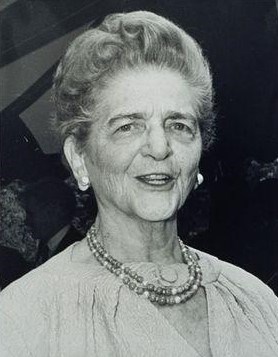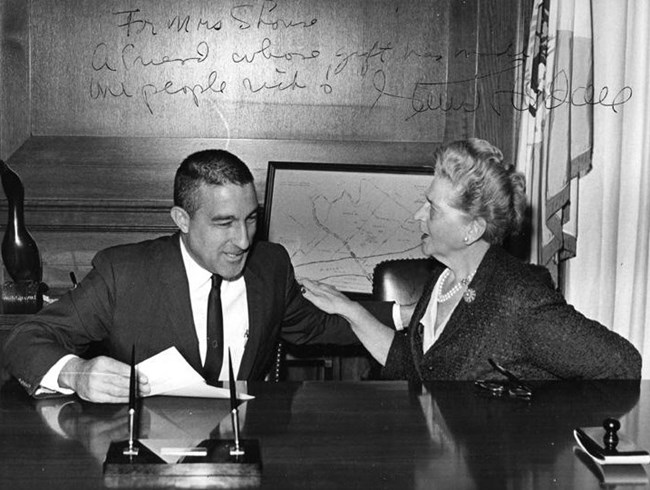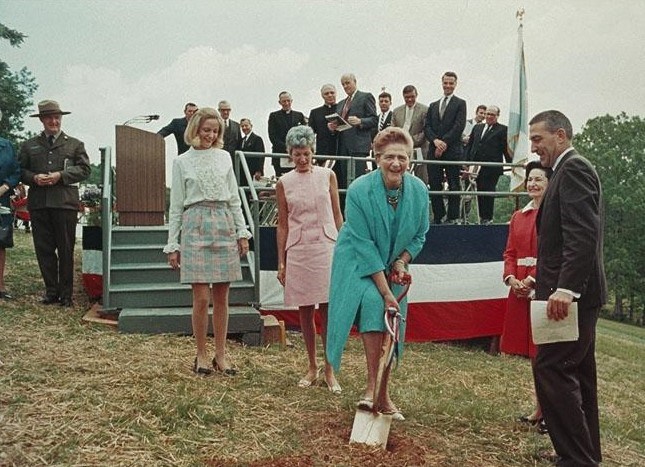Last updated: November 2, 2023
Article
Setting the Stage for a National Park for the Performing Arts

Photograph courtesy of the Schlesinger Library at the Radcliffe Institute, Harvard University.
Support for the Arts from Secretary Udall
Secretary Udall encouraged government promotion of the arts and humanities during both the Kennedy and Johnson administrations.2 In 1962, the New York World-Telegram and Sun acknowledged the role that the Secretary of Interior had in this Washington cultural movement:
This town has gone absolutely mad about culture.… With big boosts from Jacqueline Kennedy, it has become chic.… [And] Oddly enough, much of the new cultural trend seems to swirl about a man whom you would not describe as the chic type at all—Secretary Udall, a rugged, outdoor fellow.3

Photo courtesy of the Schlesinger Library at the Radcliffe Institute, Harvard University.
One initiative that Secretary Udall pushed forward was the reopening of the stage at Ford’s Theatre. At the time the theater was a small NPS-managed museum, called the Lincoln Museum. It operated out of a small section of the building; the stage had been dark since the assassination of President Lincoln in 1865. When approached about reopening the theater, Udall partnered with Senator Milton R. Young (R-ND) to secure funds for its rehabilitations. In 1968, Ford’s Theatre reopened to the public after 103 years. The theater was, and still is, operated by the NPS in cooperation with the Ford’s Theatre Society. The society is a non-profit and established a partnership with the NPS through a public-private cooperative agreement. These types of agreements allow public and private institutions to work together on such development projects.4
Secretary Udall was also involved in the development of the National Cultural Center in Washington, DC. Although the idea began with the Eisenhower administration, President Kennedy initiated a $30 million fundraising campaign in November 1963, the same month in which he was assassinated. Following Kennedy’s assassination, President Lyndon B. Johnson signed legislation amending the National Cultural Center Act (1958). This allowed Johnson to rename the center the John F. Kennedy Center for the Performing Arts. Additionally, the act established the Kennedy Center for the Performing Arts as a national memorial.5 The Kennedy Center opened in 1971 and, like Ford’s Theatre, the NPS operated it in a public-private agreement with a board of trustees until 1994.6
Venues in the Greater Washington, DC Area
In addition to these venues, which were still under development when Mrs. Shouse presented her park proposal, plans were in place for the construction of the Merriweather Post Pavilion in Columbia, Maryland. Completed in 1967, the Merriweather Post Pavilion became the summer home of the National Symphony Orchestra (NSO). The Merriweather Post Pavilion was constructed in the 40-acre “Symphony Woods” and included 3,000 permanent seats in addition to lawn seating.7 Prior to offering her land to the NPS, Mrs. Shouse offered it to the NSO for the development of a performing arts park. Her proposal was rejected because her property, Wolf Trap Farm, was not accessible enough for their purposes.
Other venues in Washington, DC at the time of Mrs. Shouse’s proposal include Constitution Hall and the Carter Barron Amphitheatre. Constitution Hall was founded by the Daughters of the American Revolution and opened in 1929. The hall was the largest concert venue in Washington, DC with a seating capacity of 3,702. In 1930, the NSO was founded at the hall and remained there for 41 years.8 The Carter Barron Amphitheatre in Washington, DC opened in Rock Creek Park under the management of the Sesquicentennial Commission in 1950. In 1952, the commission disbanded and the NPS assumed management of the 4,200-capacity outdoor theatre. The theatre was in its “heyday” in the 1950s, hosting performers such as Ella Fitzgerald, Louis Armstrong, and Diana Ross and the Supremes.9

Photo courtesy of the Schlesinger Library at the Radcliffe Institute, Harvard University. Photo taken by Robert L. Knudson.
Establishing Wolf Trap
Mrs. Shouse's 1964 performing arts park proposal came to Washington’s cultural leaders from an insider during a period of cultural renaissance. This, combined with Secretary Udall’s inclination to support the arts, helped move the park proposal forward.10
On October 15, 1966 an Act of Congress (Public Law 89-671) established Wolf Trap Farm Park (the park's original name) in Fairfax County, Virginia. The park was created "... for the performing arts and related educational programs, and for recreation use in connection therewith..."
DC Area Arts Venues Today: Still Only One National Park
Today, there are many performing arts and dual-purpose venues in the Washington, DC area. These include the National Theatre, Howard Theatre, the Fillmore, 9:30 Club, Theatre at MGM National Harbor, FedEx Field, Capital One Arena, Echostage, and District of Columbia Arts Center. Out of these venues, Wolf Trap National Park for the Performing Arts stands out as the only national park dedicated to the performing arts.
For more information see the Wolf Trap National Park for the Performing Arts Administrative History Update, 2021.
Endnotes
1. L. Boyd Finch, Legacies of Camelot: Stewart and Lee Udall, American Culture and the Arts (Norman: University of Oklahoma Press, 2008), 30–5.2. Finch, Legacies of Camelot, 30-5.
3. Betty Beale, “Udall Leading Capital’s Culture Kick/Interior Secretary Host for ‘Evenings,’” New York World-Telegram and Sun, March 31, 1962, B149, F2, as cited in Finch, Legacies of Camelot, 31.
4. Robinson & Associates Inc., NCR Administrative History 1952–2005, 135, 137–8; Barry Mackintosh, The National Parks: Shaping the System (Washington, DC: National Park Service, Department of the Interior, 1991), 77; Finch, Legacies of Camelot, 108–11.
5. Robinson & Associates Inc., NCR Administrative History 1952–2005, 137–38.
6. Mackintosh, The National Parks: Shaping the System, 77; additionally, NPS appropriations did not keep with the cost of repairs. As with other parks, this resulted in a backlog of maintenance work. By an act of Congress signed into law on July 21, 1994, the trustees of the Kennedy Center assumed complete jurisdiction of the Kennedy Center, Robinson & Associates Inc., NCR Administrative History 1952–2005, 138.
7. “Merriweather Post Pavilion’s 3rd season nears,” Baltimore Sun (Baltimore, Maryland), May 4, 1969.
8. Daughters of the American Revolution, “DAR Constitution Hall,” https://www.dar.org/constitution-hall.
9. NPS, “Carter Barron Amphitheatre Restoration,” https://www.nps.gov/rocr/learn/management/carter-barron-amphitheater-restoration.htm.
10. Mackintosh, Wolf Trap Farm Park: An Administrative History, 3.
